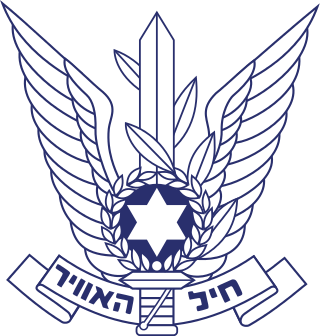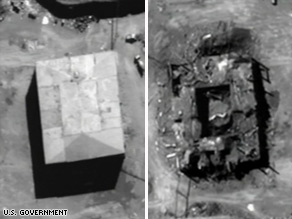
The Israeli Air Force operates as the aerial warfare branch of the Israel Defense Forces. It was founded on May 28, 1948, shortly after the Israeli Declaration of Independence. As of April 2022, Aluf Tomer Bar has been serving as the Air Force commander.

Aleppo International Airport is an international airport serving Aleppo, Syria. The airport is serving as a secondary hub for Syrian Air and Cham Wings.

Operation Outside the Box, also known as Operation Orchard, was an Israeli airstrike on a suspected nuclear reactor, referred to as the Al Kibar site, in the Deir ez-Zor region of Syria, which occurred just after midnight on 6 September 2007. The Israeli and U.S. governments did not announce the secret raids for seven months. The White House and Central Intelligence Agency (CIA) subsequently confirmed that American intelligence had also indicated the site was a nuclear facility with a military purpose, though Syria denies this. A 2009 International Atomic Energy Agency (IAEA) investigation reported evidence of uranium and graphite and concluded that the site bore features resembling an undeclared nuclear reactor. IAEA was initially unable to confirm or deny the nature of the site because, according to IAEA, Syria failed to provide necessary cooperation with the IAEA investigation. Syria has disputed these claims. Nearly four years later, in April 2011 during the Syrian Civil War, the IAEA officially confirmed that the site was a nuclear reactor. Israel did not acknowledge the attack until 2018.

The Syrian Air Defense Force (SyADF), officially the Syrian Arab Air Defense Force is an independent command within the Syrian Armed Forces. It is responsible for protecting the Syrian airspace against any hostile air attacks. The SyADF is one of the most powerful and combat-tested air defence forces in the region.

The History of the Israel Air Force begins in May 1948, shortly after the formation of the State of Israel. Following Israel's declaration of independence on May 14, its pre-state national institutions transformed into the agencies of a state, and on May 26, 1948, the Israeli Air Force was formed. Beginning with a small collection of light aircraft, the force soon transformed into a comprehensive fighting force. It has since participated in several wars and numerous engagements, becoming what has been described as "The mightiest air force in the Middle East".

The January 2013 Rif Dimashq airstrike was an aerial attack in the Rif Dimashq Governorate of Syria, which targeted a convoy alleged to be carrying weapons from Syria to the Lebanese Shi'a militia Hezbollah. The convoy was attacked on 31 January 2013. According to several media sources, Israeli forces allegedly conducted the strike, however Israel hasn't officially responded to the allegations.
The Scientific Studies and Research Center (SSRC), better known by its French name Centre D'Etudes et de Recherches Scientifiques (CERS), is a Syrian government agency that has the goal of advancing and coordinating scientific activities in the country. It works on research and development for the economic and social development of Syria, especially the computerization of government agencies. It is considered to have better technical capacity and equipment than the Syrian universities. Jane's Information Group Intelligence Services and other analysts believe it is responsible for research and development of nuclear, biological, chemical and missile technology and weapons, including ballistic missiles, as well as advanced conventional arms.

The May 2013 Rif Dimashq airstrikes were a series of aerial attacks made on targets in Syria on 3 and 5 May 2013. The 3 May attack was on targets at Damascus International Airport. The 5 May attacks were on targets at Jamraya, and the Al-Dimas and Maysalun areas in Rif Dimashq. Although officially Israel neither confirmed nor denied its involvement, former Mossad director Danny Yatom and former government member Tzachi Hanegbi inferred Israel's involvement in the attack. Official Syrian sources denied any attack on its soil on 3 May, but did accuse Israel for the attacks on 5 May.

Several incidents have taken place on the Israeli–Syrian ceasefire line during the Syrian Civil War, straining the relations between the countries. The incidents are considered a spillover of the Quneitra Governorate clashes since 2012 and later incidents between Syrian Army and the rebels, ongoing on the Syrian-controlled side of the Golan and the Golan Neutral Zone and the Hezbollah involvement in the Syrian Civil War. Through the incidents, which began in late 2012, as of mid-2014, one Israeli civilian was killed and at least 4 soldiers wounded; on the Syrian-controlled side, it is estimated that at least ten soldiers were killed, as well as two unidentified militants, who were identified near Ein Zivan on Golan Heights.

The December 2014 Rif Dimashq airstrikes were a series of aerial attacks made on targets in Syria on 7 December 2014. The targets were a military area in Al-Dimas and the Damascus International Airport area.
Events in the year 2015 in Israel.

The March 2017 Israel–Syria incident took place on 17 March 2017, when Israeli Air Force struck a target in Syria. In response the Syrian Army fired several S-200 missiles at Israeli jets above Golan Heights. Israel reported that one Syrian missile had been shot down by an Arrow 2 missile, while none of its aircraft had been damaged. Israel stated it was targeting weapon shipments headed toward anti-Israeli forces, specifically Hezbollah, in Lebanon, while the Syrian Army claimed that a military site near Palmyra had been struck.
The Iran–Israel conflict during the Syrian civil war refers to the Iranian–Israeli standoff in and around Syria during the Syrian conflict. With increasing Iranian involvement in Syria from 2011 onwards, the conflict shifted from a proxy war into a direct confrontation by early 2018.
The strikes were conducted by the Israeli Air Force late at night on 25 August 2019.
The Imam Ali military base is an Iranian military base located near the eastern Syrian town of Abu Kamal, near the border with Iraq.
The following is a timeline of the Syrian civil war for 2020. Information about aggregated casualty counts is found at Casualties of the Syrian civil war.
A series of airstrikes were carried out by the Israeli Air Force on multiple Iranian-linked targets in the Deir ez-Zor Governorate of Syria on 13 January 2021. 57 people were killed according to Israeli reports. Iranian sources confirmed the strikes, but said that only Syrian Army positions were hit. Israel carried out another airstrike in Hama nine days later, killing a family of four, including two children, according to Syrian state media.

On 28 June 2021, President Biden directed airstrikes against Iran-backed militia groups close to the Syria-Iraq border. F-15E and F-16 aircraft were used to launch the attack in what the U.S. described as a retaliatory attack against U.S. facilities and personnel in Iraq by militia groups. Two operational and weapons storage facilities were targeted in Syria, the U.S. military revealed in a statement. Despite the U.S. not disclosing the information regarding the casualties in the attack, the SOHR stated that at least nine Iran-backed Iraqi militia fighters died, leaving many others injured. Iraqi militia groups aligned with Iran in a statement named four members of the Kataib Sayyed al-Shuhada faction they said were killed in the attack on the Syria-Iraq border.
The following is a timeline of the Syrian civil war for 2021. Information about aggregated casualty counts is found at Casualties of the Syrian civil war.








